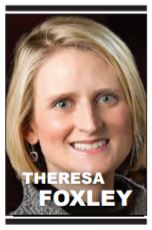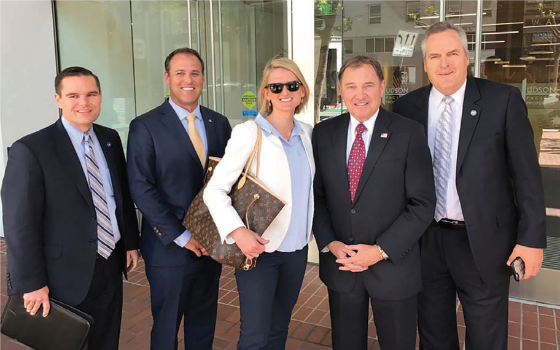 EDITOR’S NOTE: Following the recent announcement that social media giant Facebook will build a $750 million, 970,000-square-foot data center in Eagle Mountain, Theresa Foxley, president and CEO of the Economic Development Corporation of Utah (EDCUtah), posted this report concerning the workings of the various governmental and private entities involved in luring the facility to Utah. The report appeared on the EDCUtah website as part of Foxley’s weekly post called “The Fox Report.”
EDITOR’S NOTE: Following the recent announcement that social media giant Facebook will build a $750 million, 970,000-square-foot data center in Eagle Mountain, Theresa Foxley, president and CEO of the Economic Development Corporation of Utah (EDCUtah), posted this report concerning the workings of the various governmental and private entities involved in luring the facility to Utah. The report appeared on the EDCUtah website as part of Foxley’s weekly post called “The Fox Report.”
I’m so excited to finally be able to share more details about Facebook’s selection of Eagle Mountain for its next data center expansion. This is a huge team win for Utah and so many people played critical roles at critical times to make this project happen.
{mprestriction ids="1,3"}
I shared at the press event announcing the project that I felt a little like I had completed an actual steeplechase race, an endurance race where the participants have to overcome hurdles to reach the finish line. In this instance, we used creative problem solving to overcome obstacles and we ran fast and hard for a year to get to this point. However, the big difference between a steeplechase race and what was announced this week is that a steeplechase is an individual race and this process was very much a team effort and a team victory.
I’ll tell you a few things about this story that I’m proud of. Last May, in one of our GS&O (Global Strategy & Outreach) trips to the Bay Area, through a contact of mine EDCUtah had through my days in private legal practice, we were able to arrange a meeting between the Facebook data center team and Gov. (Gary) Herbert. At that time, Gov. Herbert expressed a strong desire for the state of Utah to partner with Facebook to create investment in the state. The Facebook data center team was extremely hospitable, but the timing wasn’t right to kick off a new project or site selection.
In a follow-up visit in July 2017, Stephanie Frohman and then-Eagle Mountain Mayor Chris Pengra met with the same team and shared the steps Eagle Mountain had taken to attract the data center investment. The city prioritized the data center attraction as part of its economic development strategy a decade ago and had taken several measures to minimize a company’s administrative burden to site a data center in the city. The company again seemed intrigued, but we were not in an active site selection process.
Fast-forward to late October 2017 and we got the call. Facebook was kicking off another data center site selection process and Utah was in the game. At that time, the company shared with us that they wanted to evaluate all viable site options and that we needed to move fast. They had capacity needs within their system that meant the dirt had to turn in June. The specs were staggering: $750 million in Phase 1 investment, continuous personal property reinvestment and the potential to add additional phases based on need.
In our kickoff meeting on Nov. 1, 2017, we were able to put 11 sites in five counties in front of the company. We knew the site needed to be within an approximately one-hour distance from an international airport, so that opened up sites in a radius from Utah County to Tooele County to Box Elder County and everything in-between.
The company spent a couple of months doing desktop analysis on the sites to see what might work. The engineering on a project like this takes a sophisticated understanding of the existing infrastructure and potential infrastructure upgrades, so there is a lot of work done to evaluate the feasibility of a site. Facebook has a very sophisticated internal team and process to do the analysis, but they also relied on some of our partners to help them with this stage of the analysis.
As you all know, site selection is a process of elimination and the company narrowed it down to the top three sites by February. In March, Eagle Mountain became the most highly prioritized site. At that time, Eagle Mountain was able to start engaging the local public bodies whose support was critical to the success of the project.
Infrastructure and Utah County’s expanded tax base opportunity are two of the most important components of this project and what gives the state and region so much upside. The company will front-load the investment of over $100 million in infrastructure. That infrastructure includes power, water, sewer, telecommunications and road infrastructure. To put that into context, the infrastructure required to support moving the state’s correctional facilities from the Point of the Mountain to the Northwest Quadrant of Salt Lake City is roughly the same. In other words, Facebook is investing about the same amount of infrastructure to support this project as the state is to support a very important public works project.
Due to the infrastructure investment, we were able to work with Dr. Laura Nelson at the Governor’s Office of Energy Development. OED’s organizational support was vital. The upsized infrastructure will allow Facebook to continue to grow at the site but it also significantly upgrades the whole Cedar Valley. With 345 kilovolts of power and a 1,000-megawatt-capacity substation, future users will have ample power. EDCUtah, as an organization, is thrilled because this makes our Elberta Mega Site that much more attractive for investment.
Additionally, Facebook is committed to net-new renewable power to operate the facility. This will create additional investment opportunities in rural Utah and other parts of the state for follow-on energy development and investment. So cool!
Another interesting part of this story that I learned is that Rachel Petersen, Facebook’s vice president of data center strategy, visited the Eagle Mountain site nearly nine years ago when she was in another role with another organization. All these years later she remembered the community and the site for its beauty and its potential. Given that so many people were involved in Utah or with the site over the years, including our key contact within the company, I draw a few important lessons. It’s always important to have our game faces on. People change roles and they take their contacts and knowledge with them. Even if something doesn’t work today it might work for some future company and some future need.
I also learned that we never know when the fruits of our labor will be ready to harvest. I thank whoever was involved in a site visit nine years ago for allowing our team the chance to bring this deal across the finish line.
I could go on and on about all of the cool things we learned through this experience and there are dozens of people to thank. In addition to the elected officials, Val Hale, Ben Hart, Thomas Wadsworth, Ifo Pili, Rob Smith, Paul Clements, Chris Pengra, Gary Hoogeveen, Cindy Crane, Aaron Sandborne, Rob Sant, David Peterson, Russ Fotheringham and several others played key roles at key times. To mix metaphors, Mike Flynn was EDCUtah’s quaterback on this and he consistently moved the ball three yards every single play.
We will share more about the project and some of the additional stories behind it in the coming weeks, but needless to say we are very excited for Eagle Mountain, Utah County and the whole state for this great win.
{/mprestriction}








